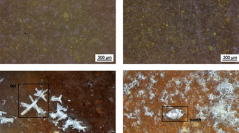

 Comptes Rendus Palevol
18 (1) - Pages 90-112
Comptes Rendus Palevol
18 (1) - Pages 90-112Petro-archaeology is a powerful tool useful in understanding the origin and management of rocks discovered in prehistoric sites and the complexity of human territories. This research technique has been applied extensively to the Massif Central and its margins, allowing the revaluation of lithic imports from the Rhodanian corridor. Flint derived from Oligocene conglomerates at Rochemaure–Cruas (Ardèche) was a perennial and often preferred source for prehistoric groups inhabiting the Vivarais lowlands and was exported through the Monts d’Ardèche to the Velay highlands (Haute-Loire) during the upper Pleistocene and the Holocene. This modifies the previously drawn litho-spaces occupied by Neanderthals and Modern Humans and questions their land-use strategies in these contrasting natural landscapes.
Flint, Barremian–Bedoulian, Massif Central, Rhodanian corridor, Mobility, Palaeolithic, Mesolithic